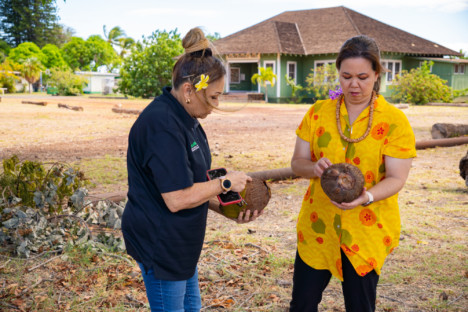The Beetle Stops Here: Interim Rule Against CRB Approved

MoMISC coordinator Lori Bucanan, left, shows U.S. Sen. Jill Tokuda a coconut infected with mites at Kapu’āiwa. Photo by Marissa Motas
By Léo Azambuja
State officials added an important layer of protection against the threat of the coconut rhinoceros beetle on Molokai, the last of the major Hawaiian Islands where the invasive pest has not been detected yet.
The Hawaii Board of Agriculture and Biosecurity voted unanimously Sept. 23 to recommend adoption of a year-long ban on landscaping and some construction materials entering Molokai from other islands. The moratorium went into the effect the following day.
“It’s a battle that we have to win when it comes to attack on our canoe crops (and) our indigenous plants,” U.S. Rep. Jill Tokuda said after meeting with Molokai/Maui Invasive Species Committee coordinator Lori Buchanan the same day the interim rule was approved.
The niu, or coconut, was one of 24 plants brought to Hawaii in canoes by early Polynesian voyagers. The niu is considered by Hawaiians as a tree of life; it provides water and food, and most of its parts are used for different purposes, including shelter, cordage and ceremonies.
The 2.5-inch dark beetle sports a large horn that makes it look like a rhinoceros. In its quest to feed on the coconut tree’s sap and tissues, the beetle bores into to the tree’s crown, tearing down fronds and severely weakening the tree, eventually killing it.
The CRB larva has a distinctive C-shape, growing up to four inches and displaying a large head and six tiny legs. The larvae are sluggish and thrive on organic matter or compost piles.
The interim rule — based on a petition by Molokai cultural practitioners Kunani and Ipo Nihipali — applies to plant, mulch, wood, soil, tree chips or any other material known to harbor the CRB or its larvae. The ban also includes gravel and other construction materials such as erosion control socks.
The Plant Quarantine Branch of the Hawaii Department of Agriculture and Biosecurity initially proposed some amendments to the rules, effectively watering down the proposal. But after overwhelming public testimony, Buchanan said the board decided to go with the proposal’s original language.
Buchanan said the same interim rule also applies to Kalaupapa, despite it belonging to Kalawao County. The rule, she said, is for the island of Molokai, and because the department has authority over the rule, they would need to enforce it in Kalaupapa as well.
Tokuda scheduled a visit to Molokai the same day the board approved the interim rule. The congresswoman met with Buchanan, and together they did a site visit at Kapuʻāiwa. Tokuda said it was sad to see that much of the coconut grove planted by King Kamehameha V had been chopped down and hit by mites and rising soil salinity.
“These are staple crops that we have depended on from when Hawaiians first came to these islands, and we have got to do everything we can to protect them,” Tokuda said.
The CRB was first detected in the Pearl Harbor-Hickam military joint base in 2013, according to Tokuda, who serves in both the Agriculture and the Armed Services committees in Congress.
The military, she said, has a responsibility and obligation to mitigate the CRB infestation, because the fact that the CRB was first found on a base “gives a good indication that the spread started from there.”
“I put in there language calling on the Department (of the Army) to specifically send back a report on how they are going to support the control and combat of CRB in Hawaii,” Tokuda said, adding it was specifically for military installations but she wants them to go beyond that because the CRB was “very likely” introduced by the military to Hawaii.











Don't have a Molokai Dispatch ID?
Sign up is easy. Sign up now
You must login to post a comment.
Lost Password